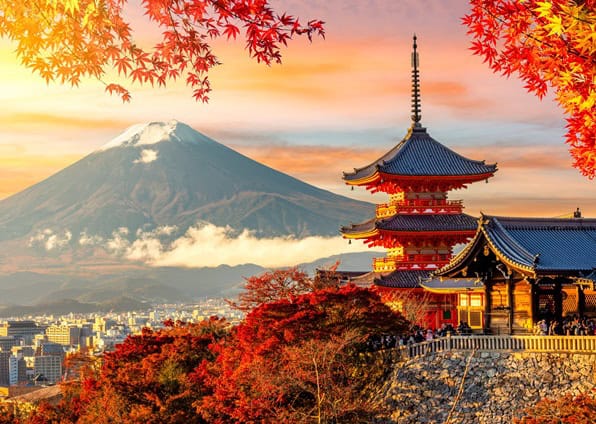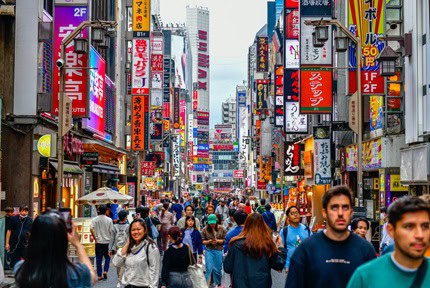

Japan Travel Guide
Best ways to experience Japan
- Explore Tokyo’s dynamic neighbourhoods – The capital city is a sensory overload in the best way. Wander through Shibuya Crossing, indulge in Harajuku street fashion, shop in Shinjuku and enjoy sushi at Tsukiji Outer Market. Culture buffs can explore Meiji Shrine or the historic Asakusa district.
- Marvel at Kyoto’s heritage – Once the imperial capital, Kyoto is a cultural treasure trove. Visit iconic temples like Kinkaku-ji (Golden Pavilion), stroll through the Arashiyama Bamboo Grove, and spot geishas in Gion.
- Hit the slopes in Hokkaido – With world-renowned powder snow, Japan is a top destination for skiing and snowboarding. Niseko and Furano are popular spots with excellent runs and hot springs nearby to relax in afterward.
- Relax in an onsen – Japan’s hot springs are a rejuvenating cultural experience. Try traditional onsen towns like Hakone, Beppu, or Kusatsu for the full experience.
- Experience the charm of Osaka – Known as Japan’s kitchen, Osaka is a haven for food lovers. Try takoyaki (octopus balls) and okonomiyaki (savoury pancakes), and enjoy the bright lights and entertainment of Dotonbori.
- Discover Hiroshima and Miyajima – Learn about Japan’s resilient spirit in Hiroshima, and take a ferry to nearby Miyajima Island to see the floating torii gate of Itsukushima Shrine.
Visiting Japan
Climate
Japan experiences four distinct seasons. Spring (March to May) brings cherry blossoms and mild weather, making it one of the best times to visit Japan. Summer (June to August) can be hot and humid, with lively matsuri (festivals) taking place across the country. Autumn (September to November) offers pleasant temperatures and colourful foliage, while winter (December to February) is ideal for snow sports and viewing illuminations, especially in the northern regions like Hokkaido.
Culture and language
The official language is Japanese, and while English is commonly used in major cities and tourist areas, learning a few local phrases can go a long way. Bowing is a traditional form of greeting and shows respect. Removing shoes before entering homes, temples, and some traditional accommodations is customary.
Japanese culture places a high value on etiquette, punctuality, and cleanliness. From ancient tea ceremonies to cutting-edge robotics, Japan’s cultural offerings are incredibly diverse. Visitors are encouraged to be mindful of local customs, especially in religious sites or rural areas.
Getting around
Japan boasts one of the most efficient and reliable public transport systems in the world. The Shinkansen (bullet train) makes long-distance travel fast and comfortable. Local trains, subways, and buses are punctual and clean.
Tourists can save money by purchasing a Japan Rail Pass in advance. Prepaid IC cards like Suica or Pasmo make getting around even more convenient, as they can be used for most transport and even shopping.
Accommodation
Accommodation options in Japan cater to all tastes and budgets. You’ll find everything from luxury hotels and modern business hotels to budget-friendly hostels, capsule hotels, and traditional ryokan inns. Peak travel times such as cherry blossom season (March–April), Golden Week (late April to early May), and New Year often require advance booking due to high demand.
Entry requirements
Australian passport holders can enter Japan for tourism without a visa for stays of up to 90 days. However, your passport must be valid for the duration of your stay. It’s wise to check the latest travel advisories and entry updates via Smartraveller or the Japanese embassy before you go.
All benefits and covers are subject to the terms, conditions, limitations and exclusions listed in the Combined Financial Services Guide and Product Disclosure Statement (PDS) and on other policy documentation, including the schedule.
Japan travel insurance FAQs
It’s always a good idea to get travel insurance when travelling to Japan, so you know you’re prepared if something doesn’t go to plan. From medical emergencies to lost luggage, travel insurance can come in handy in a variety of situations. Choosing cover that also offers instant claims can also be invaluable while travelling abroad.
No. Many Australians don’t realise that they won’t be covered by Medicare when overseas. Purchasing travel insurance with cover for medical emergencies and evacuation is essential to ensure you won’t be left to foot the bill if you become seriously sick or injured while travelling.
The best way to find out how much it will cost to get cover to travel to Japan is to get an instant quote with PassportCard. It only takes a couple of minutes to get a personalised quote by providing some basic details such as your age, destination/s, travel dates and the level of cover you would like.
Simply call our Global Assistance team on +61 1800 490 478 or contact us on WhatsApp. Our Australian-based Global Assistance team is available 24/7 and can quickly handle most common claims on-the-spot over the phone.
Preparing for your trip to Japan
Here are some helpful tips to ensure your Japan trip is as enjoyable as possible:
- Check that your passport is valid with at least 6 months beyond your intended return date
- Confirm your entry requirements with Smartraveller or the Japanese embassy
- Visit your doctor to see if you need any vaccinations for Japan
- Inform your bank of your travel plans to avoid card issues
- Arrange a travel money card and consider bringing some Japanese Yen (JPY) in cash
- Ensure your mobile phone will work overseas or purchase a Japanese SIM card or eSIM
- Book your accommodation and transport in advance during peak travel seasons in Japan
- Leave a copy of your itinerary with someone back home in case of emergency
- Organise your travel insurance with PassportCard












